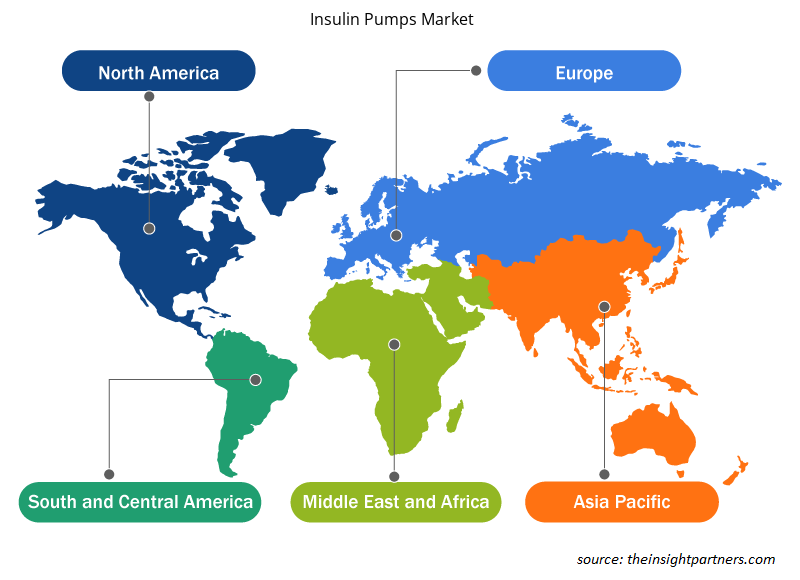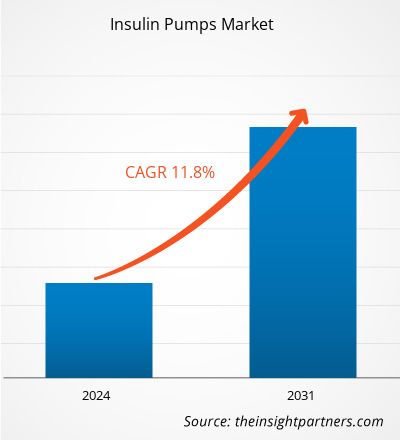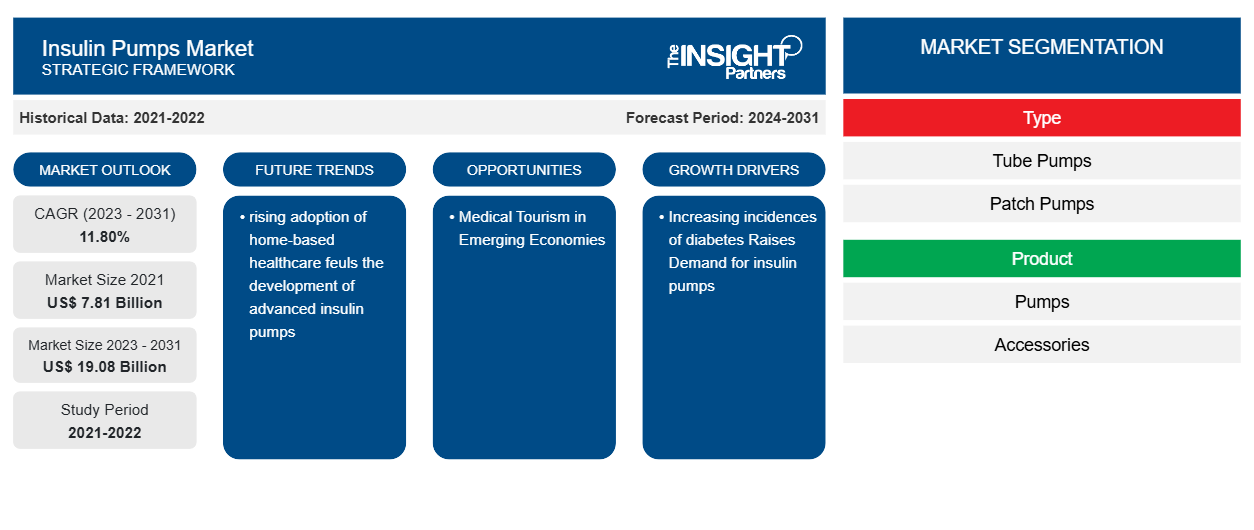Il mercato delle pompe per insulina è stato valutato a 7,81 miliardi di dollari nel 2021 e si prevede che raggiungerà i 19,08 miliardi di dollari entro il 2031. Si prevede che il mercato registrerà un CAGR dell'11,80% dal 2023 al 2031. È probabile che il progresso tecnologico rimanga una tendenza chiave del mercato delle pompe per insulina.
Analisi del mercato delle pompe per insulina
Le pompe per insulina erogano insulina, un ormone che aiuta a ridurre i livelli di zucchero nel sangue nei pazienti affetti da diabete. La terapia insulinica è un trattamento essenziale per i pazienti affetti da diabete di tipo 1 e di tipo 2. Il diabete è uno dei problemi di salute più significativi la cui prevalenza sta aumentando rapidamente. Pertanto, è necessaria una diagnosi precoce e una gestione della malattia per evitare ulteriori problemi come le malattie cardiache. L'aumento dell'incidenza e della prevalenza del diabete e dei fattori di rischio associati, tra cui cambiamenti nello stile di vita, obesità e invecchiamento della popolazione, aumentano la domanda di pompe per insulina sul mercato.
Panoramica del mercato delle pompe per insulina
Le innovazioni tecnologiche e le soluzioni intelligenti continuano a influenzare in modo significativo il mercato delle pompe per insulina.
L'Asia Pacifica è il mercato regionale in più rapida crescita per le pompe per insulina. Il mercato in questa regione è segmentato in Cina, Giappone, Corea del Sud, India, Australia e resto dell'APAC. Si prevede che la crescente prevalenza globale del diabete, l'aumento dell'incidenza di disturbi correlati allo stile di vita e l'invecchiamento della popolazione guideranno la crescita del mercato nei prossimi anni. Le pompe per insulina sono indicate per la popolazione di pazienti diabetici in quanto imitano la funzione di un pancreas normale nell'erogazione di una dose basale di insulina e dosi di bolo quando i livelli di glucosio nel sangue superano il range normale. Si prevede che la crescente prevalenza avrà un impatto significativo sulla crescita del mercato nel periodo di previsione. Inoltre, si prevede che un solido portafoglio di pipeline di prodotti e la futura commercializzazione delle pompe per insulina forniranno un'opportunità di crescita futura per questo mercato.
Personalizza questo report in base alle tue esigenze
Riceverai la personalizzazione gratuita di qualsiasi report, comprese parti di questo report, o analisi a livello nazionale, pacchetto dati Excel, oltre a usufruire di grandi offerte e sconti per start-up e università
-
Scopri le principali tendenze di mercato in questo rapporto.Questo campione GRATUITO includerà analisi di dati che spaziano dalle tendenze di mercato alle stime e alle previsioni.
Driver e opportunità del mercato delle pompe per insulina
La crescente prevalenza del diabete favorisce il mercato
Come evidenziato nel rapporto dell'American Diabetes Association pubblicato nel 2024, 38,4 milioni di americani avevano il diabete nel 2021. Tra questi, 29,7 milioni erano diagnosticati e 8,7 milioni non diagnosticati. Inoltre, il rapporto dell'International Diabetes Federation pubblicato nel 2022 ha rivelato che il Nord America e i Caraibi rappresentavano 51 milioni, l'Europa rappresentava 61 milioni, il Medio Oriente e il Nord Africa ne hanno segnalati 73 milioni, l'Africa 24 milioni, il Sud-est asiatico 90 milioni, il Pacifico occidentale 206 milioni e il Sud e Centro America rappresentavano 32 milioni di casi di diabete nel 2021.
Pertanto, la crescente prevalenza del diabete e i progressi tecnologici nei dispositivi di somministrazione favoriscono la crescita delle pompe per insulina.
Turismo medico in crescita: un’opportunità
I progressi tecnologici nell'assistenza sanitaria nei paesi in via di sviluppo stanno spingendo i pazienti a viaggiare per trattamenti migliori e convenienti e i principali attori ad espandere la propria attività. La maggior parte dei produttori di pompe per insulina si concentra sui mercati emergenti come India, Brasile, Argentina e paesi dell'America Latina a causa di un aumento della prevalenza del diabete e del crescente utilizzo di dispositivi nella regione. In India, la scienza medica è proliferata negli ultimi decenni. Il trattamento del diabete è conveniente e facilmente disponibile nel mercato emergente e le persone di altri paesi viaggiano per farsi curare. La ragione più probabile potrebbe essere le spese sanitarie eccessivamente elevate del loro paese. A causa dei tassi di cambio esistenti e di altri fattori, il trattamento per il diabete in India è diventato conveniente rispetto ad altri paesi stranieri. Pertanto, si prevede che il crescente turismo medico in nazioni emergenti come l'India fornirà opportunità significative agli attori che operano nel mercato delle pompe per insulina durante il periodo di previsione.
Analisi della segmentazione del rapporto di mercato delle pompe per insulina
I segmenti chiave che hanno contribuito alla derivazione dell'analisi del mercato delle pompe per insulina sono il tipo,
prodotto e applicazione.
- In base al tipo, il mercato delle pompe per insulina è suddiviso in pompe a tubo e pompe a patch. Il segmento Disposable potrebbe detenere una quota di mercato maggiore nel 2023.
- In base al prodotto, il mercato delle pompe per insulina è costituito da pompe biforcate e accessori. Il segmento delle pompe potrebbe detenere una quota di mercato maggiore nel 2023.
- In base all'applicazione, il mercato delle pompe per insulina è diviso in diabete di tipo I e diabete di tipo II. Il segmento del diabete di tipo 1 potrebbe detenere una quota di mercato maggiore nel 2023.
Analisi della quota di mercato delle pompe per insulina per area geografica
L'ambito geografico del rapporto sul mercato delle pompe per insulina è suddiviso principalmente in cinque regioni: Nord America, Asia Pacifico, Europa, Medio Oriente e Africa, Sud e Centro America.
Il Nord America ha dominato il mercato delle pompe per insulina. Gli Stati Uniti rappresentano una quota considerevole del mercato delle pompe per insulina in Nord America. La presenza di importanti fornitori di servizi sanitari negli Stati Uniti è tra i fattori più influenti responsabili della crescita del mercato. Si prevede che l'Asia Pacifica crescerà con il CAGR più elevato nei prossimi anni.
Approfondimenti regionali sul mercato delle pompe per insulina
Le tendenze regionali e i fattori che influenzano il mercato delle pompe per insulina durante il periodo di previsione sono stati ampiamente spiegati dagli analisti di Insight Partners. Questa sezione discute anche i segmenti e la geografia del mercato delle pompe per insulina in Nord America, Europa, Asia Pacifico, Medio Oriente e Africa e Sud e Centro America.

- Ottieni i dati specifici regionali per il mercato delle pompe per insulina
Ambito del rapporto di mercato sulle pompe per insulina
| Attributo del report | Dettagli |
|---|---|
| Dimensioni del mercato nel 2021 | 7,81 miliardi di dollari USA |
| Dimensioni del mercato entro il 2031 | 19,08 miliardi di dollari USA |
| CAGR globale (2023-2031) | 11,80% |
| Dati storici | 2021-2022 |
| Periodo di previsione | 2024-2031 |
| Segmenti coperti |
Per tipo
|
| Regioni e Paesi coperti |
America del Nord
|
| Leader di mercato e profili aziendali chiave |
|
Densità dei player del mercato delle pompe per insulina: comprendere il suo impatto sulle dinamiche aziendali
Il mercato delle pompe per insulina sta crescendo rapidamente, spinto dalla crescente domanda degli utenti finali dovuta a fattori quali l'evoluzione delle preferenze dei consumatori, i progressi tecnologici e una maggiore consapevolezza dei benefici del prodotto. Con l'aumento della domanda, le aziende stanno ampliando le loro offerte, innovando per soddisfare le esigenze dei consumatori e capitalizzando sulle tendenze emergenti, il che alimenta ulteriormente la crescita del mercato.
La densità degli operatori di mercato si riferisce alla distribuzione di aziende o società che operano in un particolare mercato o settore. Indica quanti concorrenti (operatori di mercato) sono presenti in un dato spazio di mercato in relazione alle sue dimensioni o al valore di mercato totale.
Le principali aziende che operano nel mercato delle pompe per insulina sono:
- Società Insulet
- Medtronic
- Assistenza per il diabete Tandem, Inc.
- Debiotech SA
- CELLNOVO
- Società di sviluppo SOOIL, Ltd.
Disclaimer : le aziende elencate sopra non sono classificate secondo un ordine particolare.

- Ottieni una panoramica dei principali attori del mercato delle pompe per insulina
Notizie di mercato e sviluppi recenti sulle pompe per insulina
Il mercato delle pompe per insulina viene valutato raccogliendo dati qualitativi e quantitativi dopo la ricerca primaria e secondaria, che include importanti pubblicazioni aziendali, dati di associazioni e database. Di seguito è riportato un elenco degli sviluppi nel mercato delle pompe per insulina e delle strategie:
- PharmaSens, con sede in Svizzera, ha richiesto l'approvazione della FDA per il suo sistema di pompa per insulina patch "niia essential". L'azienda ha anche ottenuto la certificazione ISO 13485 a novembre 2023 per la progettazione, lo sviluppo, la produzione e la distribuzione del sistema. Il prodotto è una pompa patch basal-bolus con un design semplificato che unisce la semplicità di una penna per insulina ai vantaggi di una pompa per insulina sofisticata. È dotata di un innovativo serbatoio da 3 ml, che la rende una delle pompe patch più compatte sul mercato. Il sistema di pompa patch per insulina incorpora anche un meccanismo di inserimento automatico dell'ago e un concetto semi-riutilizzabile per un design del prodotto sostenibile ed economicamente vantaggioso. (Fonte: PharmaSens AG, comunicato stampa, 2023)
- La Food and Drug Administration (FDA) statunitense ha approvato la pompa Beta Bionics iLet ACE e il software iLet Dosing Decision per le persone di età pari o superiore a 6 anni con diabete di tipo 1. Questi due dispositivi e un monitor del glucosio continuo integrato (iCGM) compatibile e approvato dalla FDA formano un nuovo sistema chiamato iLet Bionic Pancreas. Il nuovo sistema di dosaggio automatico dell'insulina (AID) utilizza un algoritmo per determinare e comandare la somministrazione di insulina. (Fonte: FDA statunitense, Comunicati stampa, 2023)
Copertura e risultati del rapporto sul mercato delle pompe per insulina
Il rapporto "Dimensioni e previsioni del mercato delle pompe per insulina (2021-2031)" fornisce un'analisi dettagliata del mercato che copre le seguenti aree:
- Dimensioni e previsioni del mercato a livello globale, regionale e nazionale per tutti i segmenti di mercato chiave coperti dall'ambito
- Dinamiche di mercato come fattori trainanti, vincoli e opportunità chiave
- Principali tendenze future
- Analisi dettagliata delle cinque forze PEST/Porter e SWOT
- Analisi di mercato globale e regionale che copre le principali tendenze di mercato, i principali attori, le normative e gli sviluppi recenti del mercato
- Analisi del panorama industriale e della concorrenza che copre la concentrazione del mercato, l'analisi della mappa di calore, i principali attori e gli sviluppi recenti
- Profili aziendali dettagliati
- Analisi storica (2 anni), anno base, previsione (7 anni) con CAGR
- Analisi PEST e SWOT
- Valore/volume delle dimensioni del mercato - Globale, Regionale, Nazionale
- Industria e panorama competitivo
- Set di dati Excel
Report recenti
Rapporti correlati
Testimonianze
Motivo dell'acquisto
- Processo decisionale informato
- Comprensione delle dinamiche di mercato
- Analisi competitiva
- Analisi dei clienti
- Previsioni di mercato
- Mitigazione del rischio
- Pianificazione strategica
- Giustificazione degli investimenti
- Identificazione dei mercati emergenti
- Miglioramento delle strategie di marketing
- Aumento dell'efficienza operativa
- Allineamento alle tendenze normative























 Ottieni un campione gratuito per - Mercato delle pompe per insulina
Ottieni un campione gratuito per - Mercato delle pompe per insulina